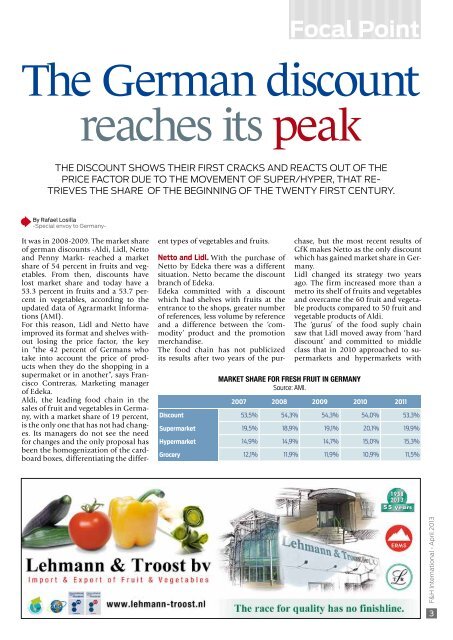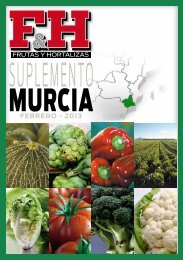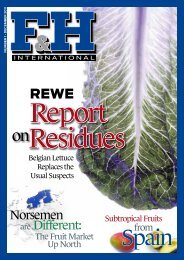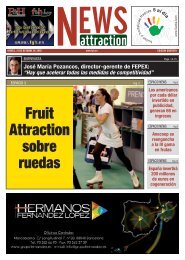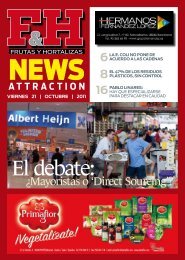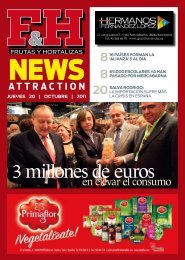Markets - Revista F&H
Markets - Revista F&H
Markets - Revista F&H
You also want an ePaper? Increase the reach of your titles
YUMPU automatically turns print PDFs into web optimized ePapers that Google loves.
Focal Point<br />
The German discount<br />
reaches its peak<br />
THE DISCOUNT SHOWS THEIR FIRST CRACKS AND REACTS OUT OF THE<br />
PRICE FACTOR DUE TO THE MOVEMENT OF SUPER/HYPER, THAT RE-<br />
TRIEVES THE SHARE OF THE BEGINNING OF THE TWENTY FIRST CENTURY.<br />
By Rafael Losilla<br />
-Special envoy to Germany-<br />
It was in 2008-2009. The market share<br />
of german discounts -Aldi, Lidl, Netto<br />
and Penny Markt- reached a market<br />
share of 54 percent in fruits and vegetables.<br />
From then, discounts have<br />
lost market share and today have a<br />
53.3 percent in fruits and a 53.7 percent<br />
in vegetables, according to the<br />
updated data of Agrarmarkt Informations<br />
(AMI).<br />
For this reason, Lidl and Netto have<br />
improved its format and shelves without<br />
losing the price factor, the key<br />
in “the 42 percent of Germans who<br />
take into account the price of products<br />
when they do the shopping in a<br />
supermaket or in another”, says Francisco<br />
Contreras, Marketing manager<br />
of Edeka.<br />
Aldi, the leading food chain in the<br />
sales of fruit and vegetables in Germany,<br />
with a market share of 19 percent,<br />
is the only one that has not had changes.<br />
Its managers do not see the need<br />
for changes and the only proposal has<br />
been the homogenization of the cardboard<br />
boxes, differentiating the differ-<br />
ent types of vegetables and fruits.<br />
Netto and Lidl. With the purchase of<br />
Netto by Edeka there was a different<br />
situation. Netto became the discount<br />
branch of Edeka.<br />
Edeka committed with a discount<br />
which had shelves with fruits at the<br />
entrance to the shops, greater number<br />
of references, less volume by reference<br />
and a difference between the ‘commodity’<br />
product and the promotion<br />
merchandise.<br />
The food chain has not publicized<br />
its results after two years of the pur-<br />
Discount<br />
Supermarket<br />
Hypermarket<br />
Grocery<br />
chase, but the most recent results of<br />
GfK makes Netto as the only discount<br />
which has gained market share in Germany.<br />
Lidl changed its strategy two years<br />
ago. The firm increased more than a<br />
metro its shelf of fruits and vegetables<br />
and overcame the 60 fruit and vegetable<br />
products compared to 50 fruit and<br />
vegetable products of Aldi.<br />
The ‘gurus’ of the food suply chain<br />
saw that Lidl moved away from ‘hard<br />
discount’ and committed to middle<br />
class that in 2010 approached to supermarkets<br />
and hypermarkets with<br />
Market share for fresh fruit in GerMany<br />
Source: AMI.<br />
2007 2008 2009 2010 2011<br />
53,5% 54,3% 54,3% 54,0% 53,3%<br />
19,5% 18,9% 19,1% 20,1% 19,9%<br />
14,9% 14,9% 14,7% 15,0% 15,3%<br />
12,1% 11,9% 11,9% 10,9% 11,5%<br />
F&H International • April 2013<br />
3


